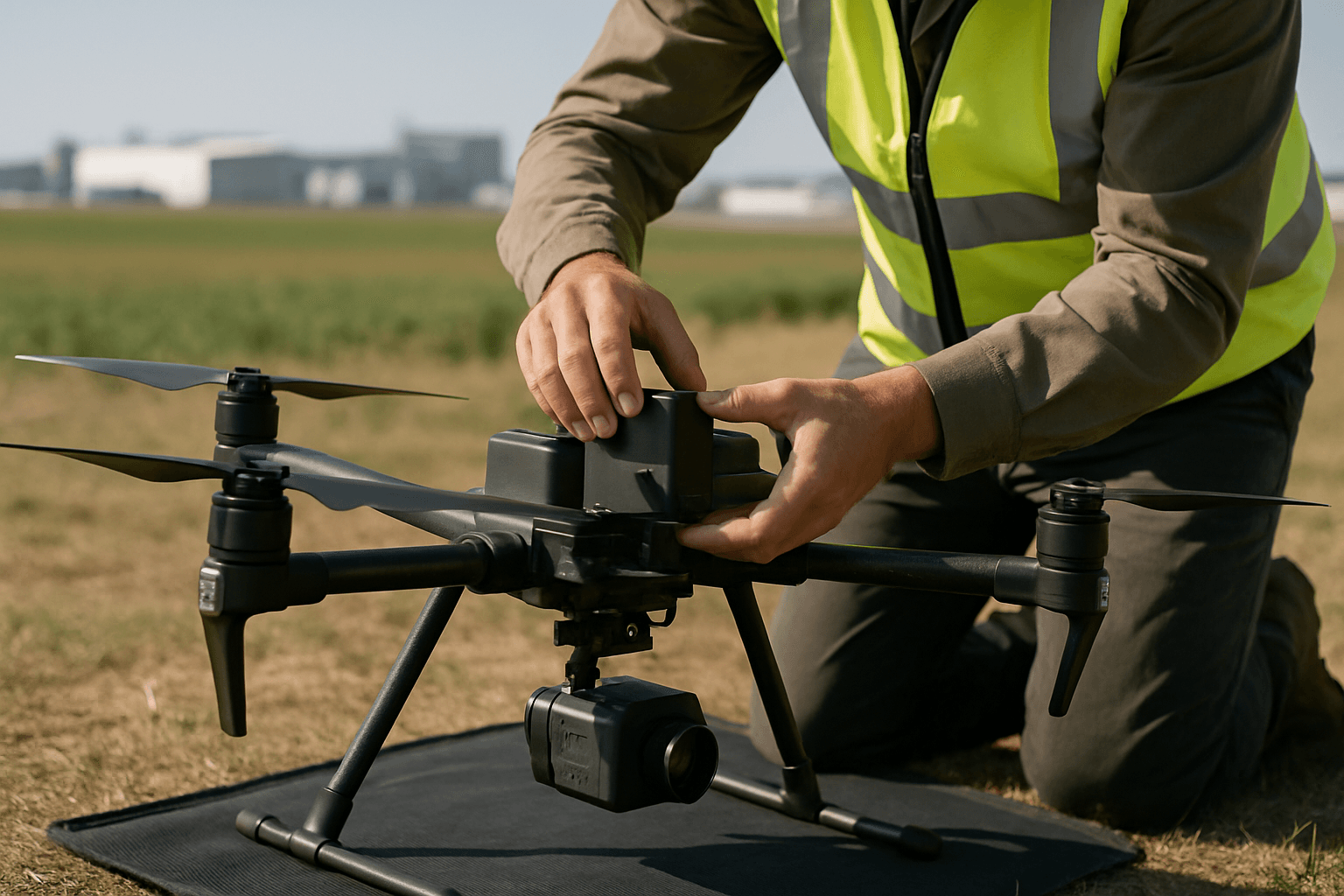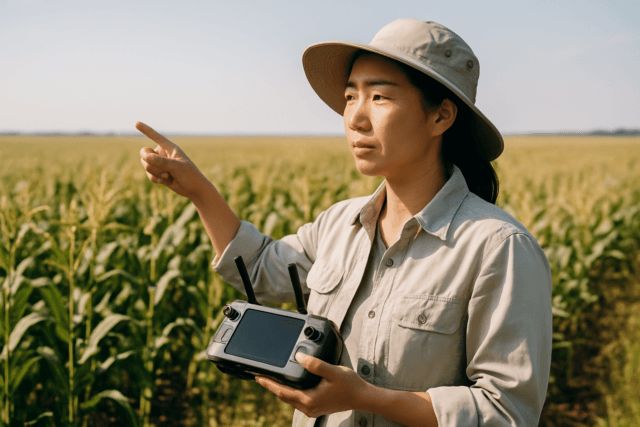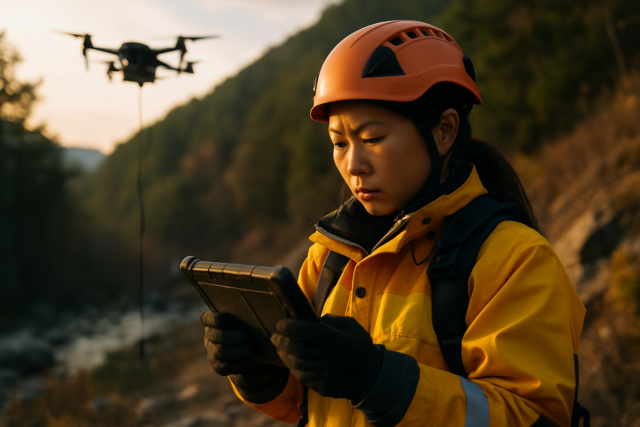Drones, also known as unmanned aerial vehicles (UAVs), have evolved from novel gadgets to essential tools across various industries. Their ability to capture real-time data, automate processes, and access previously unreachable locations is revolutionising operations and unlocking significant cost savings. Drones offer multifaceted benefits driving cost efficiency, and this article explores their impact across multiple sectors.
Streamlining Operations and Reducing Labor Costs
One of the most significant ways drones save money is by streamlining operations and drastically reducing labor costs. Traditional methods of surveying, inspection, and data collection often require large teams, specialized equipment, and extensive time commitments. Drones, however, can accomplish these tasks with significantly less manpower and in a fraction of the time.
Land Surveying
Conventional land surveying can take days or even weeks, depending on the site’s size and terrain. Drones, on the other hand, can map large areas with high precision in just minutes, collecting thousands of data points in a single flight. This rapid data acquisition translates to faster project turnarounds and reduced downtime. Depending on the site, conventional surveying can take days; with drones, it can take minutes.
Construction Site Monitoring
Drones equipped with high-definition cameras and sensors can monitor construction sites, track materials, and assess inventory in real-time. This eliminates the need for manual inspections, reduces labor costs, and allows resources to be reallocated to other critical areas of the project.
Infrastructure Inspection
Inspecting bridges, power lines, and other critical infrastructure components traditionally involves costly and dangerous manned operations. Drones can access hard-to-reach locations, assess structural integrity, and provide real-time data without putting human lives at risk, while also reducing the need for expensive equipment like scaffolding and harnesses. Drone-based dam inspection costs can be reduced by 40% to 60%. For oil and gas pipelines, drones can reduce traditional surveying costs by nearly 90%.
Last-Mile Delivery
In certain scenarios, such as delivering emergency shipments or serving low-demand areas, drones can save costs compared to traditional motorcycle or truck deliveries.
Enhancing Accuracy and Minimising Errors
Drones not only save time and labor but also enhance the accuracy of data collection, leading to fewer errors and costly rework. Their ability to capture detailed imagery and create 3D models provides a more precise representation of sites and assets compared to traditional methods.
Accurate Material Estimates
Inaccurate material estimates can lead to project delays and budget overruns. Drones can quickly provide a precise representation of a construction site, allowing for accurate material estimates and minimizing waste. Drones can quickly provide a precise representation of the area, so you can get an accurate estimate of everything you will need for the project. During a preconstruction flight, you can compare the real site to the engineer’s model, which allows you to fix any miscalculations. By correcting those errors, companies can quickly see a return on investment.
Connecting Clients to Job Sites
Drone technology allows businesses to quickly and accurately connect clients to job sites, providing them with real-time updates on project progress. This fosters trust and transparency, leading to stronger client relationships and repeat business.
Reduced Documentation Costs
Drones can reduce the amount of time and resources spent providing documentation for invoices and project reports. Aerial imagery and data can be easily integrated into these documents, providing a clear and concise record of progress.
Specific Industry Applications and Cost Savings
Drones offer cost-saving benefits across various industries:
Construction
- Reduced Labor Costs: Drones can automate site surveying and progress monitoring, reducing the need for manual labor.
- Improved Efficiency: Real-time data and aerial imagery enable better decision-making and resource allocation, minimizing delays and cost overruns.
- Enhanced Safety: Drones can inspect hazardous areas, reducing risks to human workers and potential accidents.
- Equipment Tracking: Drones simplify equipment tracking by providing real-time aerial views of the site. They can monitor the location and status of equipment, ensuring that everything is where it should be, optimizing the use of resources, reducing downtime, and preventing theft or loss of equipment.
- Identifying High-Risk Areas: Drones can quickly survey large areas and identify zones that pose a risk to workers and equipment. For example, drones can detect areas with unstable ground, excessive dust, or hazardous materials. By providing real-time data, drones enable project managers to take proactive measures to mitigate risks.
- Streamline Communications.
- Spend Less Time Surveying.
- Get Accurate Material Estimates.
- Connect Clients to Every Site.
- Create Dynamic Marketing Content.
- Overall, drones are saving construction companies time and money as well as helping construction sites become safer.
Agriculture
- Precision Farming: Drones can collect data on crop health, soil conditions, and irrigation needs, enabling farmers to optimize resource allocation and reduce waste.
- Efficient Crop Spraying: Drones can precisely apply pesticides and fertilizers, reducing chemical usage and costs.
- Livestock Monitoring: Drones can monitor livestock health and movement, enabling farmers to detect and address potential issues quickly.
- Save Time: Drones may help businesses improve their return on investment with data that helps owners reduce operating costs and improve efficiency and yields.
- Help Troubleshoot Potential Problems.
- Provide Better Data and Cost Savings from Better Images.
- Improve Health and Safety.
- Help Reduce Environmental Impact.
- When every dollar counts, getting better information while saving money could help your business.
- A U.S. drone manufacturer says for many farmers, agricultural drones are now more cost-effective than traditional machinery.
- The precision and accuracy that comes with the crop spraying and seed distribution as well as the second-to-none insights provided through that new data and visualisation are beyond valuable for your business.
Infrastructure
- Detailed Inspections: Drones can provide high-resolution images and videos of infrastructure assets, allowing for detailed inspections and early detection of potential problems.
- Reduced Inspection Time: Drones can complete inspections much faster than traditional methods, reducing downtime and labor costs.
- Safer Inspections: Drones can access dangerous or hard-to-reach areas, reducing risks to human inspectors.
- By improving efficiency, accuracy and safety, commercial drones help reduce overall project costs. Drones also help identify and mitigate risks early, preventing costly accidents and delays. Furthermore, the ability to track equipment and monitor progress in real-time leads to better resource management and reduced waste. Overall, the cost savings associated with drone usage make them a valuable investment for construction companies.
Logistics and Delivery
- Faster Delivery Times: Drones can deliver packages faster than traditional methods, especially in urban areas with traffic congestion.
- Reduced Delivery Costs: Drones can reduce fuel consumption and labor costs associated with traditional delivery methods.
- Expanded Delivery Reach: Drones can reach remote or hard-to-access areas, expanding delivery options for businesses.
- Model results showed that depot-based drone delivery led to up to 60% cost savings compared to truck-only delivery when servicing low demand in small areas.
- Drone deliveries not only reduce operating costs and are time efficient and convenient for clients, but also significantly lower carbon dioxide emissions.
Disaster Response
- Rapid Assessment: Drones can quickly assess damage and identify survivors in disaster areas, enabling faster and more effective response efforts.
- Cost-Effective Monitoring: Drones can monitor disaster zones over extended periods, providing real-time data and insights without the need for costly manned operations.
- Enhanced Safety: Drones can navigate hazardous environments, reducing risks to human responders.
- Drones can be deployed within minutes, offering immediate insights into disaster zones, which is critical for time-sensitive scenarios.
- By reducing reliance on large-scale human and vehicle deployments, drones can significantly cut operational costs.
- Drones minimize the risks to human responders by navigating hazardous environments such as fire zones or collapsed structures.
- Advanced sensors provide actionable insights that improve decision-making, reducing waste and optimizing resource allocation.
Corporate Video Production
- Enhanced Aerial Perspectives: Incorporating drones into corporate video production offers a revolutionary way to capture stunning aerial shots.
- Cost-Effective Filming: Drones have revolutionized corporate video production by offering a cost-effective alternative to traditional aerial filming methods.
- Improved Safety: In corporate video production, ensuring the safety of the crew and equipment is paramount.
- Flexibility and Accessibility.
- High-Quality Footage.
- Operating a drone typically requires only one skilled operator, reducing labor costs.
Insurance
- Gathering data before a risk is insured.
- Help in preventative management.
- Be used to assess damage after an event.
- Opportunity for insurance companies to open a new line of business with drones, and that’s creating insurance for the drones themselves.
Quantifiable Cost Savings
- Infrastructure Inspection: Drone-based dam inspection costs can be reduced by 40% to 60%. Drones can also cut the cost of thermographic inspections of utility-scale solar farms by 30% to 40%. For oil and gas pipelines, drones can reduce traditional surveying costs by nearly 90%.
- Last-Mile Delivery: Model results showed that depot-based drone delivery led to up to 60% cost savings compared to truck-only delivery when servicing low demand in small areas.
- Energy Consumption: Drones in operation consume significantly less energy than standard delivery vehicles, with estimates projected at 94% less energy per parcel.
Challenges and Considerations
Despite the numerous benefits, there are challenges and considerations associated with drone adoption:
- Regulatory Compliance: Compliance with aviation regulations and airspace restrictions is essential for safe and legal drone operations.
- Training and Certification: Qualified drone operators and maintenance personnel are needed to ensure safe and efficient operations.
- Weather Limitations: Adverse weather conditions can limit drone operations and affect data quality.
- Public Perception: Addressing concerns about privacy, noise, and safety is crucial for gaining public acceptance of drone technology.
The Future of Drone Cost Savings
The cost-saving potential of drones is poised to continue growing as technology advances and regulations evolve. Future trends include:
- Increased Automation: Advances in artificial intelligence and machine learning will enable more autonomous drone operations, further reducing labor costs.
- Improved Battery Technology: Longer battery life will increase flight times and reduce the need for frequent battery replacements.
- Enhanced Sensor Capabilities: Improved sensors will enable more detailed data collection and analysis, leading to better decision-making and cost savings.
- Expansion of Drone Delivery Services: As regulations become more favorable, drone delivery services will expand, offering faster and more cost-effective delivery options.
- As it has been demonstrated, drones already have an extremely quick delivery speed in the markets the technology operates in, but as of today the cost remains high. Based on a delivery fee and delivery speed comparison, estimates currently show the cost for parcel shipping via drone to drop from $60 per parcel package in 2020 to $4 in 2030 for roughly the same or faster delivery speed.
- Average unit cost per delivery is currently ranging between $6 and $25. This price is expected to drop by more than 70% over the next 10 years, which will not only match traditional last-mile delivery costs but surpass them and create an inflection point for the industry as it achieves widespread adoption.
- Farmers could see a 90% reduction in field application costs and they won’t have to spend hours driving spraying and spreading equipment.
Conclusion
Drones have emerged as a powerful tool for driving cost efficiency across a wide range of industries. By streamlining operations, enhancing accuracy, improving safety, optimizing resource management, and enhancing marketing efforts, drones are helping businesses save money, improve productivity, and gain a competitive edge. While challenges and considerations exist, the long-term cost-saving potential of drones is undeniable, and their adoption is poised to continue growing as technology advances and regulations evolve.





